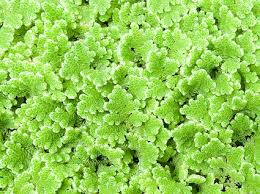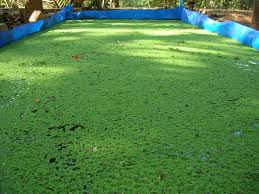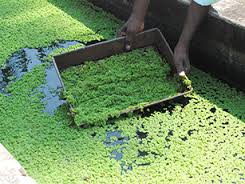 Indigenous and Frontier Technology Research Centre IFTR
Indigenous and Frontier Technology Research Centre IFTR
Design, Develop and Disseminate technologies for the masses

AZOLLA
Azolla is an aquatic fern consisting of a short, branched, floating stem with roots that hang down in the water. The leaves are alternately arranged, each consisting of thick aerial dorsal lobe containing green chlorophyll and a slightly larger thin, colourless, floating ventral lobe. The plant diameter ranges from 1-2.5 cm for small species like Azolla pinnata, to 15 cm or more like Azolla nilotica. They are triangular or polygonal in shape, and float on the surface of the water, individually or in mats. They give the appearance of a dark green to reddish carpet (rarely produced anthocyanin pigments), except Azolla nilotica which do not produce the red anthocyanin pigment.
The most interesting characteristic of azolla is its symbiotic relationship with the nitrogen-fixing blue-green alga (cyanobacterium) Anabaena azollae. The fern provides nutrients and a protective cavity in each leaf to Anabaena colonies in exchange for fixed atmospheric nitrogen and possibly other growth-promoting substances.
Azolla is new to India. However, it has been recognized as a useful plant in Southern China and Northern Vietnam, where it was used as a biofertilizer and green manure for the rice crop. Azolla production promoted heavily during 1960s in China and Vietnam not only resulted in rapid expansion in these countries, but also attracted world attention in the 1970s. While it was at peak during 1980s along with Blue green Algae, both slowly reduced in use. It was also considered as a noxious weed by farmers
Other Names
Fairy moss, Duckweed fern, Mosquito fern, Water fern [English]; helecho mosquito, helecho de agua [Spanish]; Algenfarne [German]; अजोला [Hindi]; അസോള [Malayalam]; அசோலா [Tamil];
Azolla Species [Azollaceae]
Azolla caroliniana Willd. ; Azolla filiculoides Lam; Azolla mexicana C.Presl ; Azolla microphylla Kaulf. ; Azolla nilotica Daecne. ex Mett. ; Azolla pinnata R. Br.
Contents
Azolla is very rich in proteins, essential amino acids, vitamins (vitamin A, vitamin B12, Beta Carotene), growth p
romoter intermediaries and minerals including calcium, phosphorous, potassium, ferrous, copper, magnesium. On dry weight basis, Azolla has 25-35% protein content, 15% crude fibre, 10-15% mineral content (iron - (1000–8600 ppm dry weight, copper - 3–210 ppm dry weight, manganese -120–2700 ppm dry weight), and 7-10% comprising a combination of amino acids, bio-active substances and biopolymers (vitamin A - 300–600 ppm dry weight), 15% ash, 30% nitrogen. Azolla’s carbohydrate and oil contents are very low (4.8–6.7% dry weight crude fat, with 6.1–7.7% and 12.8– 26.4% total fat for the poly
unsaturated acids omega 3 and omega 6.
In addition, Azolla do not to accumulate secondary plant compounds and therefore has a greater potential than tree leaves to source protein for monogastric animals. One hectare of Azolla can produce 540-720 kg of protein per month.
Cultivation
Normally azolla is grown in paddy fields or shallow water bodies and multiplies very rapidly over a period of time if the climate is conducive for its growth.
Bed Preparation and Maintenance

- Clean and level the soil in the area
- Line the bricks horizontally in a rectangular fashion.
- Spread a UV stabilized silpauline sheet of 2m X 2m size uniformly over the bricks in such a way to cover the margin of the rectangle made by the bricks
- Spread 10-15 kg of sieved soil uniformly over the silpauline sheet / pit
- Prepare a slurry made of 2 kg cow dung and 30 g of Super Phosphate in 10 liters of water
- Pour onto the sheet
- Add more water to raise the water level to about 10 cm
- Add @ 0.5-1kg of pure mother azolla culture seed material uniformly over the water
- Sprinkle fresh water over the azolla immediately after inoculation to make the azolla plants upright
- Wait for one week
- Azolla spreads all over the bed and develops as a thick mat.
- Add a mixture of 20 g of Super Phosphate and 1 kg of cow dung once in 5 days in order to maintain rapid multiplication of the azolla and to maintain the daily yield of 500 g
- If required, add a micronutrient mix containing magnesium, iron, copper, sulphur etc., at weekly intervals to enhance the mineral content of azolla
- Replace @ 5 kg of bed soil with fresh soil once in 30 days to avoid nitrogen build up and prevent micro-nutrient deficiency
- Replace 25 to 30 percent of water with fresh water once every 10 days to prevent nitrogen build up in the bed
- Clean the bed often, replace the water and soil and inoculate new azolla every six months
- Always discard the beds infested with pests and diseases and inoculate with pure culture of azolla
- Fresh biogas slurry, waste from bathroom, cattle shed, also be used

Harvesting
- Azolla grows rapidly and fills the pit within 10 - 15 days.
- Optimum harvesting leads to sustenance of the culture for longer period
- From 15th day always harvest only 500 - 600 g azolla daily
- Use a pla
stic filter to scoop the grown Azolla- Wash the harvested azolla in fresh water to get rid of the cow dung
- Remove azolla daily to avoid over crowding
Environmental factors
- 1. Temperature 20°C - 32°C
- 2. Light full sunlight – 50% is recommended at high heat and high lux. In such cases use shade nets to cut the light intensity.
- 3. Relative Humidity - 65 - 80%
- 4. Water 5 - 12 cm height
- 5. pH 4 - 7.5
Azolla as cattle feed
- It is the most economic and efficient feed substitute for live stock
- It is easily digested by the livestock owing to its high protein and low lignin content
- Milk yield increases by 15 to 20%
- 15 to 20% commercial feed can be replaced by azolla
- Does not
affect the milk production, but improves quality of milk and health and longevity of livestock.
Comparison of biomass and protein cotent of azolla with different fodder species (t/ha)
|
|
Annual production of biomass |
Dry matter content |
Protein content |
|
Hybrid napier |
250 |
50 |
4 |
|
Lucerna |
80 |
16 |
3.2 |
|
Cowpea |
35 |
7 |
1.4 |
|
|
40 |
3.2 |
0.6 |
|
|
730 |
56 |
20 |
P. Kamalasanana Pillai, S. Premalatha and S. Rajamony. LEISA
